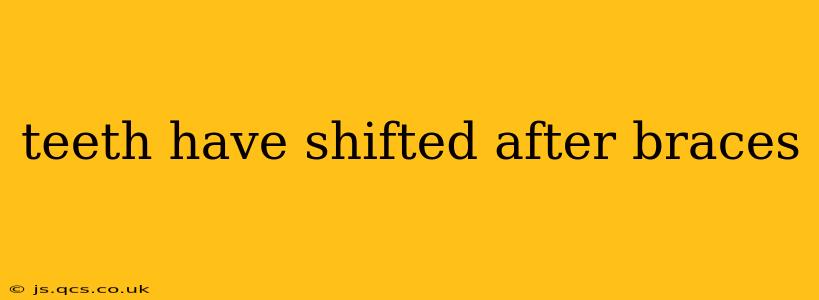Getting braces is a significant commitment, often involving years of careful treatment to achieve a perfectly aligned smile. But what happens after the braces come off? Many patients find that their teeth have shifted after braces, leading to frustration and concern. This is a common occurrence, and understanding why it happens and how to prevent it is crucial. This comprehensive guide will explore the reasons behind post-braces shifting, preventative measures, and options for correcting the issue.
Why Do Teeth Shift After Braces?
Teeth are constantly moving, even after orthodontic treatment. The forces that moved your teeth into their new positions during treatment are gone, and your teeth are now subject to the natural pressures exerted by your lips, tongue, and chewing muscles. This constant pressure, combined with the natural tendency for teeth to revert to their original positions, can cause teeth to shift over time.
What Causes Teeth to Shift After Braces?
Several factors contribute to post-braces shifting:
-
Lack of Retention: This is the most common reason. Retention involves wearing retainers, which are custom-made appliances designed to hold your teeth in their corrected positions. Failing to wear retainers diligently, or wearing them improperly, significantly increases the likelihood of relapse.
-
Genetics: Your genetic predisposition plays a role in the stability of your teeth. Some individuals naturally have more stable teeth than others.
-
Poor Oral Hygiene: Gum disease or periodontal issues can weaken the support structures surrounding your teeth, making them more susceptible to shifting.
-
Age: Bone density changes with age, potentially affecting the stability of teeth.
-
Grinding or Clenching: Bruxism (teeth grinding) can exert considerable force on your teeth, leading to shifting even with retainers.
How Long Does It Take for Teeth to Shift After Braces?
The timeframe for noticeable shifting varies considerably, depending on the factors mentioned above. Some individuals might experience minor shifting within months, while others might see significant changes after several years. Consistent retainer use minimizes this risk.
How Can I Prevent My Teeth From Shifting After Braces?
Preventing teeth from shifting after braces largely relies on diligent adherence to your orthodontist's instructions regarding retainer use.
-
Wear Your Retainers as Prescribed: This is paramount. Your orthodontist will provide specific instructions on how long and how often you should wear your retainers. Strictly following these instructions is crucial for maintaining your results.
-
Maintain Excellent Oral Hygiene: Brushing and flossing twice daily, along with regular dental checkups, are essential for maintaining healthy gums and supporting tooth stability.
-
Avoid Harmful Habits: Quitting habits like nail-biting or chewing on pens or pencils can significantly reduce the risk of shifting.
-
Consider Permanent Retention: In some cases, your orthodontist might recommend permanent retainers, which are bonded to the back of your teeth. This offers a higher level of stability but might be less comfortable than removable retainers.
Can I Get My Teeth Straightened Again If They Shift?
Yes, if your teeth have shifted after braces, you can have them straightened again. Your orthodontist can assess the extent of the shifting and recommend the most appropriate treatment, which might involve Invisalign, traditional braces, or other corrective methods.
What are the Different Types of Retainers?
Several retainer types exist, each with its advantages and disadvantages:
-
Removable Retainers: These are typically made of clear plastic or wire and can be removed for cleaning and eating.
-
Fixed (Bonded) Retainers: These are cemented to the back of your teeth and are permanently in place.
-
Hawley Retainers: These are removable retainers with a wire that fits around the teeth.
Your orthodontist will recommend the most suitable retainer type based on your individual needs.
What Should I Do If My Teeth Have Shifted After Braces?
Don't panic! Schedule an appointment with your orthodontist as soon as possible. They can assess the situation and recommend the best course of action to correct the shifting. Early intervention is key to minimizing further movement and making any necessary corrections more manageable.
By understanding the factors contributing to post-braces shifting and diligently following your orthodontist's recommendations, you can significantly improve your chances of maintaining your beautiful, straight smile for years to come. Remember, proactive measures and regular checkups are your best allies in this process.
